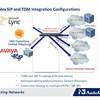 Being close partners with both Skype and Microsoft, I’ve been living in a dual UC environment for over two years, using Microsoft Lync and Skype at the same time. Depending on who I needed to communicate with, I had to choose either the Lync or Skype client to initiate the conversation. Frequently swapping from one client to the other between conversations (fortunately, I can use the same headset). Things get real interesting when I need to pull in both Skype and other non-Skype capable co-workers into the same conversation.
Being close partners with both Skype and Microsoft, I’ve been living in a dual UC environment for over two years, using Microsoft Lync and Skype at the same time. Depending on who I needed to communicate with, I had to choose either the Lync or Skype client to initiate the conversation. Frequently swapping from one client to the other between conversations (fortunately, I can use the same headset). Things get real interesting when I need to pull in both Skype and other non-Skype capable co-workers into the same conversation.
Besides juggling the two clients, I must maintain two presence statuses, two directories and two profiles. Sometimes I feel like I live two parallel lives in two parallel universes.
With today’s announcement that Microsoft has reached an agreement to purchase Skype, it appears my two worlds are soon converging. But I don’t expect dramatic changes overnight, there are many technical differences between Microsoft Lync and Skype that I suspect will make the integration a slow, but steady evolution.
For starters, Microsoft and Skype both have proprietary high-definition media coders (RTA from Microsoft and SILK from Skype). In both cases, they’ve made huge investments in the development of the coders and both have significant market penetration. RTA is built into Lync and fantastic at adapting to enterprise network conditions, but Skype’s SILK coder works much better over the open internet where network conditions change minute-to-minute. If you have to choose one, which do you choose?
Beyond the media, directory management tools, status and presence will all need to be integrated. As Skype is an “over the top” service, using the customer’s existing broadband internet service, security has some special challenges too.
Fortunately, you can integrate Skype Connect with Microsoft Lync for calling features today. Using an Enterprise Session Border Controller (E-SBC) in a Back-to-Back User Agent (B2BUA) mode, Skype Connect low-cost calling and inbound Skype Client access can be integrated to Microsoft Lync. The E-SBC also provides that added security needed to protect the enterprise against external attack or abuse.
Using an E-SBC to integrate Skype Connect with Microsoft Lync allows businesses to offer Skype-IDs to the public, enabling “call me” buttons on web sites, replacing toll-free 800 services with free Skype calling. To me, this seems like an obvious initial investment to reduce operating costs while improving customer access to the increasingly mobile consumer and business markets.
I am looking forward to further integration, but see the immediate opportunities for voice integration as a valuable first step.
Like the Ghostbuster characters, sometimes you need to cross the streams to shake things up (let’s just hope we get more than a giant marshmallow man to show for the investment)
For more information on this topic, visit the Microsoft Lync and Skype Connect Integration resource page.

-thumb-autox90-10361.jpg)











Leave a comment